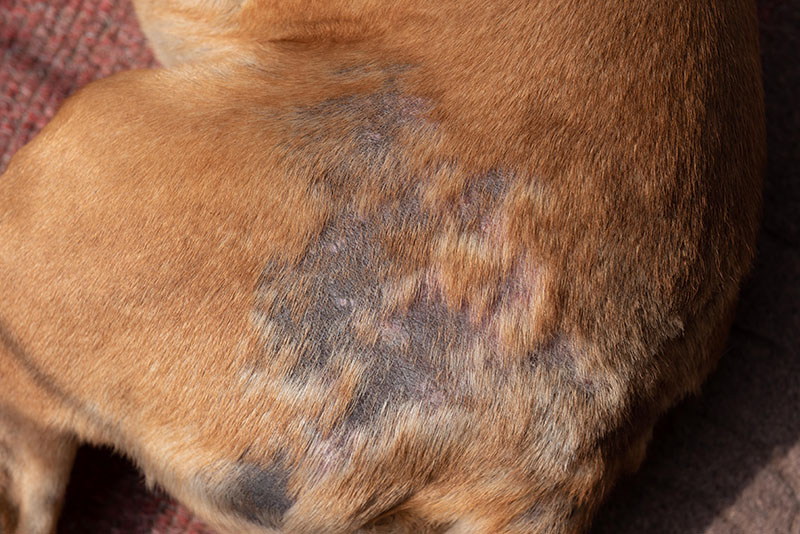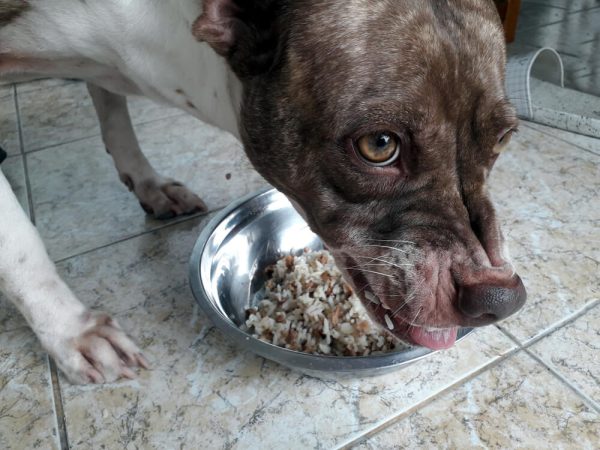If you haven’t heard of scabies in dogs, you may have heard it called one of its other names: Sarcoptes, sarcoptic mange, or even just “mange.” However, mange can technically be caused by any parasitic mite. Here, we’re focusing on one specific mite: Sarcoptes scabiei. This is the mite that causes scabies, or sarcoptic mange, in canines. This skin disease makes dogs extremely itchy, so it’s important that your pet is protected against it. You should also know what to do if your vet has told you that your dog has scabies.
This article covers everything from the causes and signs of scabies to the care and treatment of this bothersome disease.

What Is Scabies?
Let’s start by discussing mites. Although commonly mistaken for insects, mites are actually more closely related to spiders, right down to the presence of eight legs. Despite that relationship, however, mites are tiny and can only be seen with a microscope, not the naked eye.
Sarcoptes scabiei is a particular mite that infests canines. They can be picked up from other infested dogs, from foxes in the wild, or from the environment (where they can survive for a few days). The mite makes itself at home on your dog’s skin, causing intense itchiness. Although scabies is not life-threatening, it will make your dog extremely uncomfortable, so it’s important to protect your pet against mites and know what signs to keep an eye out for.
What Are the Signs of Scabies?
Scabies causes typically quite severe itchiness. Most dogs will relentlessly scratch at their skin, causing inflammation and significant self-trauma. Scabies mites have a preference for hairless skin, meaning that some parts of the body are more likely to be affected, like the elbows, ears, and belly.
Eventually, if the mites are untreated and the scratching persists, the skin becomes inflamed, thickened (“scaly”), and dark. Most dogs will not seem unwell—that is, they maintain their appetite and energy levels—though some dogs can be so itchy that they start to act abnormally.

What Are the Causes of Scabies?
Scabies is caused by the mite Sarcoptes scabiei, which is typically picked up from other infested dogs or the environment. But how does the mite live on your dog’s skin?
Scabies mites initially feed on the material on the surface of your dog’s skin. It’s worth noting here that unlike some other parasites (such as fleas), scabies mites do not feed on blood. Eventually, the female mite burrows under the skin and lays eggs. After these eggs hatch into larvae and then develop into nymphs, they crawl on the skin. Once they become adult mites, they mate, and the females burrow again to lay more eggs.
But why do scabies mites cause so much itchiness? There are two reasons for this. First, the burrowed female mite triggers an intense allergic response from your dog’s immune system. This means your dog is sending all kinds of inflammatory cells toward the mite to try to fight off the infestation. Second, the presence of those pesky nymphs and larvae crawling over the skin after hatching is incredibly itchy.
To make things worse, dogs will often scratch themselves so much that they traumatize the skin, enabling bacteria to enter and cause secondary infections. Unfortunately, this results in more itchiness.
How Do I Care for a Dog With Scabies?
Fortunately, treatment options are available and effective for scabies. There are two broad categories of treatment, and we recommend discussing with a veterinarian which option is best for your dog.
Topical Treatments
These products are applied directly to the skin, killing the mite. A few types are available, and most need to be re-applied fortnightly or monthly.
Oral Treatments
These are tablets, chews, or liquids that can be given to your dog to treat the mites. Some of these are technically used “off-label,” meaning that although these medications are not licensed to treat mites, veterinarians will prescribe them because they are known to be effective.
Some vets may also prescribe a course of antibiotics. These will not treat the scabies mites; instead, they are used to treat the secondary bacterial infections, as these can persist once the mites are gone. Similarly, anti-inflammatories are often used to settle the itchiness while waiting for the mite treatments to kick in.
At home, it is best to separate your infested dog from any other pets you have. It’s also a good idea to discard or wash any bedding, soft toys, leads, collars, or harnesses that may have been contaminated.
We recommend you consult a veterinarian for the best advice on which would be the best treatment for your pup.
If you need to speak with a vet but can't get to one, head over to PangoVet. It's our online service where you can talk to a vet online and get the advice you need for your dog — all at an affordable price!


Frequently Asked Questions
Can I Get Scabies From My Dog?
Yes. Although scabies cannot survive and lay eggs on your skin (as it is “host-specific” to dogs), it can make its way onto your skin and cause severe itchiness. Most mites will only survive a few days on your skin, but this can be enough to cause a skin rash. If you or anyone in contact with your infested dog develops these signs, contact your doctor and notify them of the circumstances.
Can My Cat Get Scabies From My Dog?
Scabies mites can survive on cats for a few days, but they cannot complete their life cycle on felines, so the itchiness tends to only last a few days. However, cats can contract their own kind of mange from a different mite (known as Notoedres cati). This is technically called notoedric mange, and although the signs are similar to sarcoptic mange in dogs, it is a different mite that is specific to cats.

How Does My Veterinarian Diagnose Scabies?
The best way to diagnose scabies is with a test called a “skin scrape.” To do this test, your veterinarian will scrape the surface of the skin with a scalpel blade and then examine this material under a microscope. If the vet is lucky, they will be able to see the scabies mites under the microscope. It only takes a few mites to cause the signs of itchiness. Jpweer, if the mites are burrowed deep into the dog’s skin, it can be difficult to actually collect the mites in the scraping. These two factors can result in a “false negative” on the skin scrape test.
If your vet is suspicious of scabies but does not visualize any mites under the microscope, they may recommend a treatment trial. This is a safe and affordable alternative to other, more advanced tests, such as biopsy or skin allergen testing. A treatment trial involves using either topical or oral medications to treat mites and then waiting for 2–4 weeks to see if the signs resolve. If the signs resolve with treatment, we can be fairly confident that scabies was causing the itchiness.

Final Thoughts
If you think your dog may have scabies or has been exposed to an infested dog, always arrange a consultation with your veterinarian. Thankfully, excellent treatment options are available to fix the problem. Early treatment with effective products will eradicate the mites and minimize any itchiness or discomfort for your dog.
Featured Image Credit: RJ22, Shutterstock


















